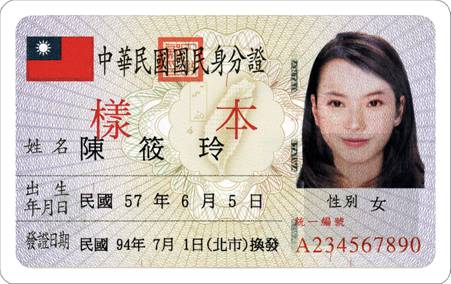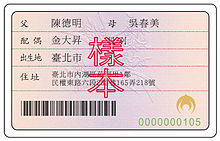Names of people in Taiwan have had a default format for many decades. For example:
- Lee Teng-hui
- Chen Shui-bian
- Ma Ying-jeou
- Tsai Ing-wen
The similarity, however, is not in use of a single romanization system. None of those names share the exact same romanization system or combination of systems:
- Lee (common phonetic spelling) Teng-hui (Wade-Giles)
- Chen Shui-bian (Hanyu Pinyin!)
- Ma Ying (Wade-Giles, probably) jeou (Gwoyeu Romatzyh)
- Tsai (bastardized Wade-Giles) Ing (ad hoc spelling) wen (Wade-Giles, probably)
But, different as those people are and different as the romanization systems used are, all of those names share an obvious pattern that marks them as belonging to someone in Taiwan: the hyphen joining the two parts of the given name, and the use of a lowercase letter for the second part of the given name.
Around twenty years ago, during Taiwan’s romanization wars (when President Chen wanted to impose Tongyong Pinyin upon Taiwan and a great many foreigners and others reacted with dismay and disgust), a popular claim of the Tongyong supporters was, “If Taiwanese use Hanyu Pinyin for their names, no one will be able to tell Taiwanese from Chinese anymore.”
This, however, was, like most claims of Tongyong supporters, not true. (It was also pretty funny, given that the most powerful supporter of Tongyong Pinyin was Chen Shui-bian, whose name is unambiguously Hanyu Pinyin but whom no even remotely knowledgeable person would ever mistake for someone from the PRC). The style used for names in China is “Familyname Givenname” (no hyphen). All Taiwanese have to do to keep their names distinct is to preserve the hyphen (assuming they even desire to use Hanyu Pinyin, which is not now nor has ever been required here for personal names).
This is easy:
- PRC vs. TAIWAN
- Li Denghui vs. Li Deng-hui
- Chen Shuibian vs. Chen Shui-bian
- Ma Yingjiu vs. Ma Ying-jiu
- Cai Yingwen vs. Cai Ying-wen
But a few years back the government of Taiwan announced that it would be issuing a new style of the national ID card. Based on the mock-ups the government supplied, these cards would include romanization (yea!), but romanization in a very un-Taiwanese style (argh!).
What’s especially odd, though, is that the romanization clearly follows the style of names in Singapore, not Taiwan.
Here, for example, are the names of some prominent Singaporeans:
- Lee Kuan Yew
- Goh Chok Tong
- Lee Hsien Loong
Again, the standard pattern for Singaporean names is easy to discern … and clearly distinct from the standard pattern of names in Taiwan.
Why is the government doing this? Switching from Taiwan style to Singapore style makes no sense — not historically, not practically (separating given names makes it harder to tell what’s the family name and what’s the given name), and not politically.
And why on earth is “林” being romanized on the card as “LING” rather than as “LIN”, and “森” as “SHENG” rather than as “SEN”? Typos in not one but both of the only two personal names given do not inspire confidence.
Her name should be given, in descending order of preference, as
CHEN Xiao-lin
Chen Xiao-lin
or CHEN XIAO-LIN
not CHEN XIAO LING.
I had been hopeful that the cards and their new style had simply been killed off and so the problem had been effectively eliminated years ago. But according to a recent Taiwan News story, the “eID scheme is halted but not scrapped.” So this nonsense might still happen.
The only good thing I have to say about the Pinyin on the mock-ups (other than its existence) is that it is at least not prohibitively tiny, which is a common problem.
By the way, hyphens can appear in some names in Hanyu Pinyin — but not in the way many people may first guess. Two-syllable family names are written solid, not hyphenated (e.g., Ouyang and Sima, not Ou-yang and Si-ma). Rather, hyphens exist in standard names in China in Hanyu Pinyin in cases where someone decides to adopt her spouse’s name but also preserve her maiden name. So, if a Ms. Wang marries a Mr. Li but wants to have both names, she becomes Ms. Wang-Li (or Ms. Li-Wang).
Here’s what Taiwan’s national ID cards look like presently:
Further reading:
Contractor seeks NT$526 million in compensation for Taiwan’s halted digital ID plan. Taiwan News, May 8, 2023.




Unhyphenated names would definitely be a bad move. Here in the UK, I often see Singaporean or Malaysian given names mangled by people treating them as western-style first and middle names, using just the first character plus surname. To make it worse, this is often the generation name, so not the character they would use even if they abbreviate their names amongst family and friends (as it would be the same for all siblings). I know Malaysians who have either taken to hyphenating their names to avoid this happening, or given up and just started to use one syllable.
Off topic, what’s with capitalizing the whole surname? From an English-speaking perspective it’s jarring.
Joseph, this seems common in France for example. I guess it’s to identify which is the surname, and also in the case of European names, it shows where a name is double-barrelled, and whether parts such as “le” or “de” or “von” are considered part of the surname.
Hong Kong names can also be separated without hyphens, and this too has led to Anglophone overuse of the one syllable shared by siblings (whether a generation name or an ad-hoc one), see http://ssb22.user.srcf.net/law/midname.html (some Hong Kongers have English names officially registered along with their Chinese names, but the English name might or might not be officially first, and therefore might or might not be used by institutions that insist on treating only the part up to the first space as the name to call a person)
Regarding the rendering of “林” as “LING” and “森” as “SHENG”, I notice the old sample has the names 玲 (ling) and 昇 (sheng). Perhaps it’s not a coincidence?
I agree with the author of this text. And I go even a step further (Singapore, Macao and Hong Kong):
I dont know why many people cant see the problems if you are using old and outdated romanizations.
I can only say so much in general, I am taking a korean soccer player as example:
1) Kim Min Jae
2) Kim Min-Jae
3) Kim Min-jae
4) Kim Minjae
Dont matter if Mainland China, Hong Kong, South- or North Korea, if you are communicating with people around the world, who usually have absolute zero clue about chinese/korean names, avoid 1 completely, it only leads to confusions.
2 is still possible, but it’s also technically not really correct. It looks like a double-barreled [given] name, like Anna-Maria for example.
I dont get it why people in the area’s of Singapore or Macao still use the 1 method, try that in the west and anyone thinks it’s a first/given and a middle name, like John Fitzgerald Kennedy, Michael Jai White or Michael Jeffrey Jordan.
Middle names dont exist in chinese and korean, but they to exist in vietnamese, which makes it even more complex.
I’ll give you examples:
Kim, Min Jae (Korean)
Chiang, Kai Shek (Chinese)
Michael Jai White (American)
Nguyen, Van Quyet (Vietnamese)
All four examples looke like first/given, middle and last/family names.
Now I gonna use modern romanizations for chinese and korean:
Kim, Minjae (Min-jae)
Chiang, Kaishek (Kai-shek)
Michael Jai White
Nguyen, Van Quyet
There you can see Minjae and Kaishek are first/given names, and nothing is a middle name.
And the given name of Mr Nguyen is actually only Quyet, Van is a middle name.
That’s only a suggestion to me, but exspecially the method 1 as i listed above should never be used in latin western writings for chinese or korean names, it only leads to confusions.
If you watch wikipedia for example, back in the day Bruce Lee wrote his full name like this:
Bruce Jun Fan Lee, or Bruce J. F. Lee
The problem was when he was a young kid in the 1940s, he learned it that way. But it only leads to confusions.
Today in the wiki article about first, middle- and last names, it’s spelled “Bruce Junfan Lee”.
Like the korean actor Charles Seunghee Lee. If he would use the old romanizations, he would spell his name as “Charles Seung Hee Lee”, which would look just weird for western people who are used to latin alphabet.
Buttom line: If people from Singapore, Macao etc. communicate among other chinese and korean people, who knew middle names dont exist in their languages, it’s ok to use the 1 method. But communicating with the rest of the world, 3 or 4 are the best ways and there wont be any confusions.